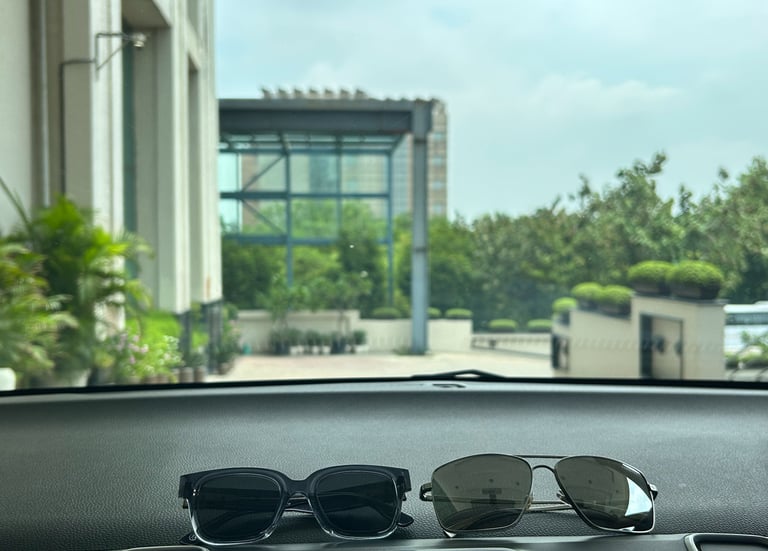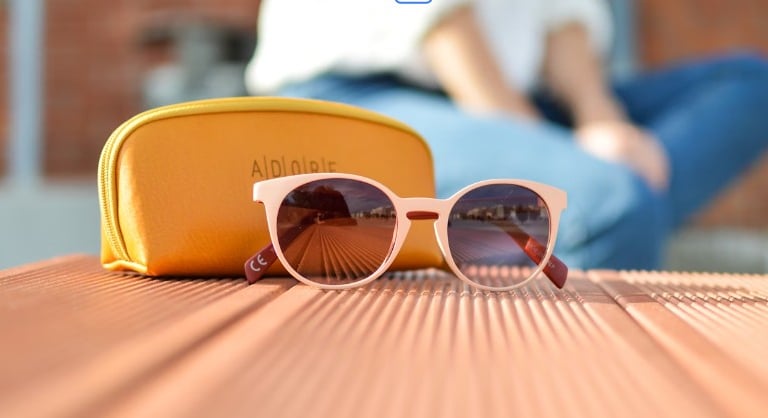Sunglasses Goddess: The chemistry behind the glare
6/16/2025
"Chemically Speaking: UV Rays? Not today!"
Understanding Lens Material Composition
When choosing the perfect sunglasses, understanding the lens material is crucial as it significantly affects durability, optical clarity, and weight. The most common materials used in sunglass lenses include polycarbonate, glass, and plastic, each with distinct characteristics and benefits.
Polycarbonate lenses are renowned for their impact resistance, making them an excellent choice for active individuals or those who frequently engage in outdoor activities. This lightweight material is less prone to shattering, which enhances safety for the wearer. Additionally, polycarbonate lenses provide good optical clarity, although they may not be as scratch-resistant as their glass counterparts. Consequently, investing in a good anti-scratch coating can prolong the life of polycarbonate sunglasses.
Glass lenses, on the other hand, excel in optical clarity, offering superior visual acuity. They tend to have excellent scratch resistance, which enhances their durability in everyday use. However, glass lenses are heavier than their polycarbonate and plastic peers, which might pose a slight inconvenience during extended wear. Furthermore, if they do break, glass can shatter into sharp pieces, presenting a safety concern. Therefore, while they provide outstanding optical performance, careful handling is required.
Plastic lenses, often made from CR-39 resin, are another popular choice. They are lightweight and can be produced in various tints and coatings, providing versatility in style and function. However, plastic lenses are generally more prone to scratching than polycarbonate or glass lenses. Despite this, their affordability and customization options make them appealing to many consumers.
Ultimately, the choice of lens material should align with individual lifestyle needs and preferences. Factors such as the level of physical activity, frequency of use, and desired optical performance play a vital role in making the right selection. Understanding the pros and cons of each material will enable consumers to choose sunglasses that best suit their requirements.
The Importance of UV Protection Coating
When selecting sunglasses, one of the most critical factors to consider is UV protection. Ultraviolet (UV) rays are a form of radiation emitted by the sun, which can have detrimental effects on the eyes. Prolonged exposure to UV radiation can lead to several eye problems, including cataracts, macular degeneration, and even certain types of cancers.
Thus, investing in sunglasses with a proper UV protection coating is essential to safeguard your vision.
Sunglasses with UV protection can effectively filter out these harmful rays. The key metric to look for is the sunglasses' UV rating, which indicates the level of protection they offer. Generally, sunglasses rated UV400 provide the highest level of protection, blocking out 99% to 100% of UVA and UVB rays. In contrast, lower-rated sunglasses may only block a fraction of these harmful rays, leaving the eyes vulnerable to potential damage. It is important to note that not all sunglasses provide adequate UV protection, regardless of their dark tint or polarization.
When shopping for sunglasses, consumers should always check for labels indicating UV protection and consider brands that prioritize this feature. Many reputable brands offer sunglasses that undergo rigorous testing to ensure UV protection meets safety standards. By choosing sunglasses with a high UV protection rating, wearers can enjoy the outdoors without compromising their eye health. Furthermore, investing in quality sunglasses can prove to be cost-effective in the long run, as they help prevent future vision problems related to UV exposure.
In conclusion, understanding the importance of UV protection coating in sunglasses is vital for maintaining eye health. Choosing sunglasses with the right level of UV protection not only enhances comfort and clarity of vision but also serves as a crucial strategy in protecting against long-term eye damage.
Harmful Effects of UV Rays
Ultraviolet (UV) rays emitted from the sun are invisible forms of radiation that can cause significant harm to the eyes. Prolonged exposure to these rays can lead to a variety of ocular health concerns, making it imperative for individuals to prioritize protection when choosing sunglasses. One of the primary risks associated with UV exposure is the development of cataracts, a clouding of the lens in the eye that can severely impair vision. Studies have indicated that excessive UV exposure is a contributing factor to the formation of cataracts, underscoring the importance of high-quality sunglasses that offer adequate UV protection.
Another serious condition linked to UV radiation is macular degeneration, a leading cause of vision loss in older adults. The macula, which is a small area of the retina responsible for clear central vision, can be damaged by UV light over time, leading to progressive vision deterioration. Protecting the eyes from UV rays is crucial for preventing this condition, thus highlighting the responsibility of informed consumers to select sunglasses with sufficient UV-blocking capabilities.
Additionally, it is essential to acknowledge the risk of skin cancers around the eyes, including basal cell carcinoma and melanoma. The sensitive skin surrounding the eyes is particularly vulnerable to the harmful effects of UV radiation, which can lead to significant health risks if left unprotected. Consequently, wearing sunglasses that incorporate full UV protection can mitigate these risks not only for the eyes but also for the surrounding skin.
In light of these alarming risks, the selection of suitable sunglasses becomes paramount.
Consumers should opt for sunglasses that offer 100% UV protection to safeguard their eye health against the detrimental effects of UV rays. By making educated choices, individuals can effectively enhance their protection against potential ocular issues stemming from UV exposure.
Polarization Technology: Enhancing Vision
Polarized lenses in sunglasses represent a significant advancement in eye protection and comfort, especially for individuals frequently exposed to bright conditions. These lenses possess a special chemical coating that filters out horizontal light waves, effectively reducing glare. Glare often originates from reflective surfaces such as water, roads, or snow, which can distract or hinder visibility. By mitigating this overwhelming brightness, polarized sunglasses enhance visual clarity, allowing for a more comfortable experience while outdoors.
The benefits of polarization extend across various activities, making them particularly advantageous in diverse environments. For example, when driving, polarized sunglasses help reduce the blinding effects of sunlight reflecting off the pavement, fostering safer driving conditions. Likewise, anglers often favor polarized lenses as they allow for better visibility beneath the water's surface. By cutting through the glare, these sunglasses reveal fish and underwater structures that would otherwise go unnoticed, thereby improving fishing success rates.
Outdoor sports enthusiasts, including cyclists and runners, also find polarized sunglasses to be invaluable.
The reduced glare not only minimizes discomfort but also enhances depth perception and contrast, essential factors for maintaining focus and balance during activities. Additionally, during recreational outings such as skiing, polarized lenses combat the intense sunlight reflecting off the snow, protecting the eyes and enhancing visual acuity in an often blinding environment.
In summary, the incorporation of polarization technology in sunglasses offers multiple advantages, notably in glare reduction and visual enhancement across various activities. Therefore, when choosing sunglasses, it is beneficial to consider polarized options, especially if engaging in environments prone to bright light and reflections.
Photochromic Lenses: The Conversion Marvel
Photochromic lenses, often referred to as transition lenses, represent an innovative advancement in eyewear technology that adapts to changing lighting conditions. These lenses are designed to darken when exposed to UV light, such as that from the sun, and revert to their clear state once indoors or in the absence of UV rays. This unique capability provides individuals with a seamless eyewear solution, eliminating the need for multiple pairs of glasses while offering enhanced visual comfort.
One of the primary advantages of photochromic lenses is their convenience. For those who frequently move between indoor and outdoor environments, these lenses provide a practical option, transitioning quickly and effectively based on the ambient light. This eliminates the hassle of constantly switching between sunglasses and prescription eyewear, ultimately enhancing the user experience for individuals whose daily activities involve frequent shifts in lighting conditions.
Furthermore, photochromic lenses offer significant eye protection. The faintly tinted state serves not only to reduce glare but also to block harmful UV rays that can lead to long-term eye health issues. Individuals who prioritize their ocular safety will find great value in photochromic options, which offer superior coverage compared to standard clear lenses.
When selecting photochromic lenses, one must consider lifestyle and usage scenarios. Individuals who spend substantial time outdoors, be it for sports or leisure, may require lenses that darken more quickly and offer a larger range of tints. Conversely, those who primarily use their lenses indoors may prefer a model that provides optimal clarity with minimal darkening. Regardless of choice, the versatility of photochromic lenses makes them an ideal solution for various users, seamlessly blending functionality with style.
Color Tints and Dyes for Sunglasses
When selecting sunglasses, the color tints and dyes are crucial elements that significantly influence visual comfort and clarity. Different colors serve unique purposes, catering to various environments and activities. Understanding these differences can enhance not only the aesthetic appeal of sunglasses but also contribute to eye health and performance.
Grey lenses are among the most popular choices for sunglasses, known for their ability to reduce overall brightness without distorting colors. This makes them suitable for a broad range of activities, including driving and sports, where true color perception is essential. Grey tints are particularly useful in bright, sunny conditions, providing excellent glare reduction while ensuring that the view remains natural and balanced.
On the other hand, brown tints enhance contrast and depth perception. They filter out blue light significantly, which makes them a great option for activities such as golfing or biking, where details matter. Brown tints can provide warmth to the view, making colors appear richer without overwhelming brightness. This characteristic can be beneficial in varying lighting conditions, especially during the early morning or late afternoon.
For low-light environments or overcast days, yellow tints are ideal as they increase contrast, enhancing visibility in foggy or dim conditions. They can make details stand out and improve overall visual comfort during such challenging weather. However, yellow lenses should be used cautiously in bright sunlight, as they can amplify glare instead of reducing it.
Ultimately, the choice of tint depends on personal preference and the specific activities planned. By understanding the benefits of various colors, individuals can select sunglasses that not only suit their style but also provide optimal visual performance in diverse environments.
Advanced Coatings: Anti-Reflective, Mirror, and Scratch-Resistant Options
When selecting the perfect sunglasses, understanding the advanced coatings available is essential for enhanced visual comfort and protection. Among the most prominent coatings are anti-reflective, mirror, and scratch-resistant options, each offering distinct advantages that cater to various needs.
Anti-reflective coatings are designed to minimize glare from surfaces such as water, roads, and other bright environments. By reducing reflections on the lens, this coating significantly improves clarity and contrast, making it particularly beneficial for activities like driving or outdoor sports. Individuals who spend extended periods outdoors will appreciate the reduced eye strain that comes with effectively eliminating distracting reflections.
Mirror coatings, on the other hand, are characterized by their reflective surface that offers a stylish appeal while providing substantial functional benefits. These coatings reflect sunlight away from the eyes, thereby reducing glare and enhancing visual comfort in bright conditions. Often chosen by athletes and outdoor enthusiasts, mirror-coated lenses can also enhance color perception, making them an excellent option for activities like skiing or cycling.
Lastly, scratch-resistant coatings play a crucial role in maintaining the longevity and appearance of sunglasses. These coatings create an invisible shield on the lens surface, helping to resist minor scratches that can occur during daily wear and tear. Choosing lenses with scratch-resistant properties can keep sunglasses looking new for a more extended period, providing both aesthetic and practical benefits.
Incorporating these advanced coatings into your sunglass choice empowers you to customize your eyewear for specific environments and activities. Whether you prioritize glare reduction, style enhancement, or durability, understanding each coating's functionality can greatly influence your decision-making process in selecting the ideal pair of sunglasses.
Choosing Sunglasses Based on Face Shape
Selecting the right sunglasses involves understanding how different frames complement various face shapes. Each facial structure has unique characteristics that can be enhanced or softened by the right pair of shades. To make an informed decision, it's essential to identify your face shape, which generally falls into one of four categories: oval, round, square, and heart-shaped.
For those with an oval face, which is characterized by balanced proportions and slightly wider cheekbones, most sunglasses styles will work well. Cat-eye and aviator frames are particularly flattering, as they accentuate the natural symmetry of the face. These styles also keep pace with current trends, making them a popular choice among fashion-forward individuals in India.
Individuals with a round face, distinguished by soft curves and a width equal to the height, can opt for rectangular and square frames. These angular designs add definition and help elongate the appearance of the face. In recent years, oversized sunglasses have gained traction, presenting an ideal mix of style and functionality for those with round shapes.
Square faces, identifiable by a strong jawline and broad forehead, benefit from rounded or oval sunglasses. These shapes contrast the angular features and soften the overall appearance. Light-colored frames can also add a playful touch, appealing to modern aesthetics prevalent in Indian fashion.
Lastly, heart-shaped faces, with narrower chins and wider foreheads, are best complemented by frames that are wider at the bottom, such as cat-eye or butterfly styles. Such designs can create balance by drawing attention to the lower face. This particular shape has seen a resurgence in popularity in recent Indian trends, where artistic frame designs are celebrated.
Incorporating these styles based on face shape and staying attuned to local fashion tendencies will greatly aid in finding a perfect pair of sunglasses tailored to individual preferences and features.






Contacts
Socials
Subscribe to our newsletter
support@otgscience.in
Copyright © 2024 otgscience.in
.
